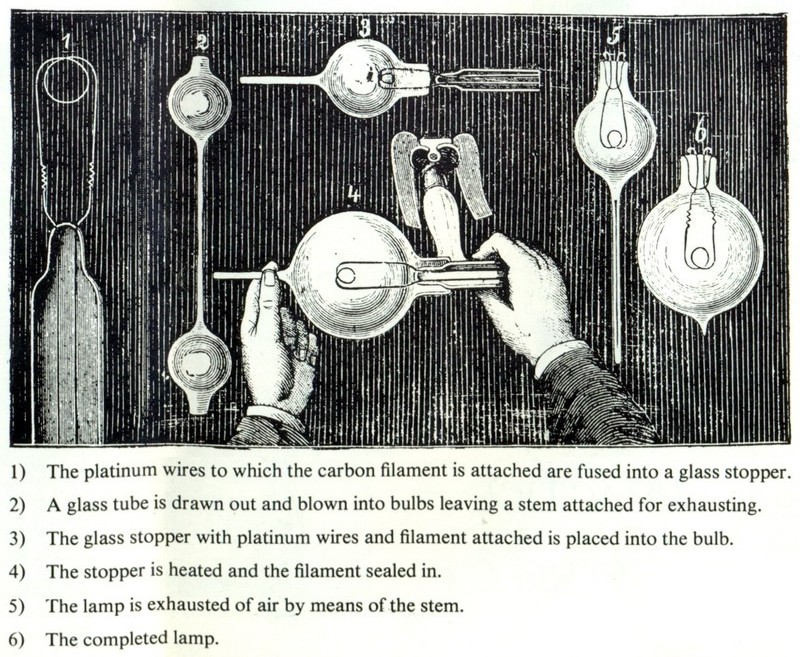|
|
|
It was not until Swan's 1880 lighting of the first private residence in the world to be lit with incandescent lamps (that of Sir William Armstrong at Cragside, Northumberland), and the world's first incandescent streetlighting installation (on Mosely Street, Newcastle-upon-Tyne), that demand began to escalate rapidly and Swan required a larger factory. The South Benwell works was opened in 1881, and because at that time other pioneers in incandescent lighting were still producing their lamps under essentially laboratory conditions, Benwell holds the title of being the first incandescent lamp factory in the world. It was to be a short-lived success however. By 1886 still larger premises were required, and the factory followed Swan to his new home in London.
|

Staff outsite the Swan Electric Light Co. Benwell factory, 1881
|
| Address |
South Benwell, Newcastle-upon-Tyne, United Kingdom |
| Location |
Unknown |
| Opened |
1881. Re-opened ca. 1901 |
| Closed |
1886. Second closure 1913 |
| Products |
Carbon filament lamps |
Early History
The first lamps of Sir Joseph Swan were produced jointly between his own laboratory in Low Fell where the filaments were prepared and carbonised, and then sent to the Birkenhead laboratory of the skilled vacuum engineer, Charles Henry Stearn, to be sealed into evacuated glass bulbs. The process was exceptionally delicate and the only man able to make the first prototypes was Fred Topham, a highly skilled young glassblower employed by Stearn. By 1881 demand had grown to the level that a dedicated factory was required, and Swan acquired an old tannery in Benwell which had been established in 1843 by the Priestman family. Fred Topham moved from Birkenhead to Benwell, and to pass his skills on to other factory staff, he recruited a team of the best glassblowers from the Thuringian district of Germany. A small army of local girls was also hired to perform the task of forming the fragile filaments, a job which until then had been performed by the ladies of Swan's own household.
In scaling up the operations from laboratory scale to industrial mass production, Benwell was aided greatly by the contribution of Colonel R.E.B. Crompton of the famous arc lighting company, as well as Mr. Henry Edmunds. Mr. Charles Gimingham joined the early team and made many contributions towards simplifying the lamp design for more efficient production, while Swan's brother Alfred devoted himself to developing improved lamp caps and holders. Alfred Swan, who later emigrated to the USA and took up employment at General Electric's Euclid Lamp Works is most famously responsible for his invention of vitrite, the special black electrically insulating glass still used to this day in the caps of electric lamps. |

Processes in the Manufacture of 1883-style Short Neck Swan Lamps at Benwell
|
Relocation to Ponders End
Benwell grew rapidly, especially following the 1883 amalgamation of the Swan Lamp Company with Thomas Edison's operations, to create the Edison & Swan United Electric Light Company. The wise decision of these two men to put aside their legal differences and pool their patents and knowledge freed the market from the crushing forces of the otherwise inevitable patent litigation, and established sound business prospects. By 1886 the factory had outgrown this original small site and it was clear that a location closer to the main markets in the South, and nearer to Swan's new home in London, would be desirable. In March of that year new premises at Ponders End in East Middlesex were identified, and by the end of May the relocation of plant, lamp stocks and a substantial portion of the skilled Benwell workforce had been completed. The loss of the lamp factory had a tremendous impact on Benwell. Many of the employees followed the work down south, and practically every shop in the small town closed down due to the loss of its customers. |
The Second Benwell Era
This was not to be the end of Benwell however. Some twenty years after the company's foundation the demand for its lamps was continuing to escalate, and Ponders End itself reached full capacity. The booming business called for a re-opening of Benwell as well as a new factory in Cheshire. Meawhile to cater for overseas demand Swan's associates had established lamp factories in Kalk, Germany and Paris, France. The expensive Parisian location was swiftly relocated to the industrial Flemish city of Rijsel, which is today known by its present name of Lille. Benwell was to prosper for another decade and the intense price competition between the different Ediswan factories kept the entire business sharply focussed on making lamps at the most competitive costs. Ponders End however remained the principal manufacturing operation and when the opportunity for expansion of that site presented itself, a purpose-built vast, single production hall was constructed to house all of the company's lampmaking operations under a single roof. Following its completion Benwell once again became surplus to requirements, and was finally closed in 1913 before being taken over by its new owners, the South Benwell Motor Cycle Works.
|
| 1 |
J W Swan and the Invention of the Incandescent Electric Lamp, C N Brown, The London Science Museum, 1978. |
| 2 |
Sir Joseph Swan Inventor and Scientist, Mary E. Swan & Kenneth R. Swan, Oriel Press, 1968. |
| 3 |
Sir Joseph Swan and the Invention of the Incandescent Electric Lamp, Kenneth R. Swan, Longmans, Green & Co., 1948. |
| 4 |
The Pageant of the Lamp, Published by the Edison-Swan Electric Company Ltd., approx. 1948. |
| 5 |
Timmonet History of Newcastle-Upon-Tyne. |
|
|
|
|
|